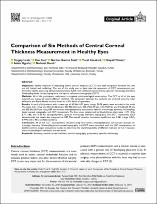Comparison of Six Methods of Central Corneal Thickness Measurement in Healthy Eyes
Citation
Ucak, T., Icel, E., Tasli, N. G., Karakurt, Y., Yilmaz, H., Ugurlu, A., & Demir, M. (2021). Comparison of Six Methods of Central Corneal Thickness Measurement in Healthy Eyes. Beyoglu Eye Journal, 6(1), 7.Abstract
Objectives: Several methods of measuring central corneal thickness (CCT) have been compared, however, the data are still limited and conflicting. The aim of this study was to determine the agreement of CCT measurements performed in healthy eyes using ultrasound pachymetry (USP), non-contact tono/pachymetry, specular microscopy, biometry, Scheimpflug-based corneal topography, and optical coherence tomography (OCT). Methods: All of the participants underwent a complete ophthalmological examination. The CCT of all of the eyes included was measured using 6 different methods. The agreement between the methods was analyzed using the mean difference and Bland-Altman analysis based on a 95% limits of agreement. Results: A total of 64 patients with a mean age of 40.96±14.52 years (range: 20-78 years) were included in the study. The mean CCT value was 552.10±35.65 ?m, 550.40±35.55 ?m, 554.67±35.49 ?m, 545.39±34.21 ?m, 546.25±35.49 ?m, and 552.64±33.59 ?m using USP, non-contact tono/pachymetry, non-contact specular microscopy, biometry, Scheimpflugbased corneal topography, and OCT, respectively. The bias values determined by Bland-Altman plots were -1.70, -2.56, 6.71, 5.85, and -0.53 for tono/pachymetry, specular microscopy, biometry, topography, and OCT, respectively. OCT demonstrated the lowest bias compared to USP. The overall intraclass correlation coefficient was 0.961 (range: 0.945- 0.974) with a 95% confidence interval. Conclusion: All of the CCT measurements obtained using non-contact tono/pachymetry, non-contact specular microscopy, biometry, Scheimpflug-based corneal topography, and OCT were consistent with the USP measurements of healthy controls. Larger prospective studies to determine the interchangeability of different methods for CCT measurements in pathological conditions are warranted.
Volume
6Issue
1URI
https://doi.org10.14744/bej.2021.17894https://app.trdizin.gov.tr/makale/TkRJM05ESTRPQT09
https://hdl.handle.net/11491/8309
Collections
- Makale Koleksiyonu [524]
- TR-Dizin İndeksli Yayınlar Koleksiyonu [1602]


















